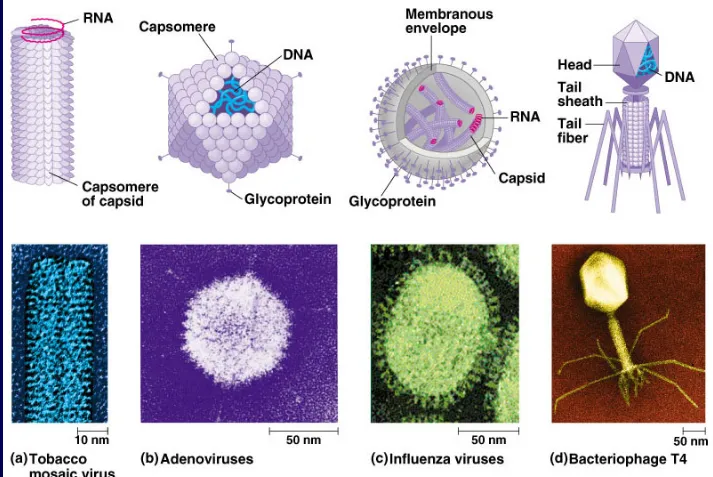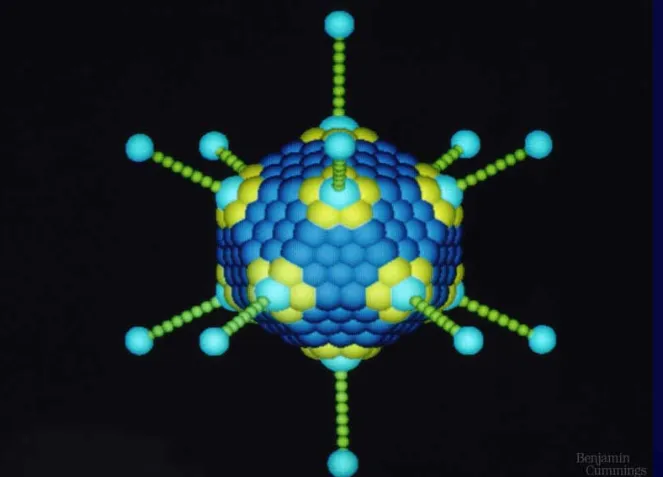3. STRUKTUR DAN FUNGSI SEL MIKROORGANISME
4. PERTUMBUHAN MIKROORGANISME
5. GENETIKA MIKROORGANISME
6. BIOENERGETIKA MIKROORGANISME
7. PENGENDALIAN PERTUMBUHAN MIKROORGANISME
8. INTERAKSI DAN PENYEBARAN MIKROORGANISME
9. PERANAN MIKROORGANISME
MIKROBIOLOGI
MIKROBIOLOGI
I.
PENDAHULUAN
II.
EVOLUSI DAN KERAGAMAN MIKROBA
III.
TINGKATAN TAKSONOMI
IV. SISTEM KLASIFIKASI
V.
KARAKTERISTIK UTAMA YANG DIGUNAKAN DALAM
TAKSONOMI
VI. PERKIRAAN (
ASSESSING)
FILOGENI MIKROBA
VII. DIVISI UTAMA ORGANISME
VIII. BERGEY’S MANUAL OF SYSTEMATIC BACTERIOLOGY
IX. GARIS BESAR FILOGENI DAN KERAGAMAN PROKARIOT
X.
MENGENAL LEBIH DEKAT ANGGOTA DUNIA MIKROBA
A. ARCHAEA
B. BACTERIA
C. FUNGI
D. ALGAE
1. EARLY DEVELOPMENT OF VIROLOGY
2. GENERAL PROPERTIES OF VIRUSES
3. THE CULTIVATION OF VIRUSES
4. VIRUS PURIFICATION AND ASSAYS
5. THE STRUCTURE OF VIRUSES
6. PRINCIPLES OF VIRUS TAXONOMY
7. BACTERIOPHAGES
8. VIRUSES OF EUCARYOTES
POKOK BAHASAN
Edward Jenner:
Edward Jenner:
published case reports of successful attempts to prevent disease published case reports of successful attempts to prevent disease
(smallpox) by vaccination
(smallpox) by vaccination
these attempts were made even though Jenner did not know that these attempts were made even though Jenner did not know that
the etiological agent of the disease was a virus
the etiological agent of the disease was a virus
Dimitri Ivanowski
Dimitri Ivanowski
demonstrated that causative agent of tobacco mosaic disease demonstrated that causative agent of tobacco mosaic disease
passed through bacterial filters
passed through bacterial filters
thought agent was toxinthought agent was toxin
1798
1892
1. EARLY DEVELOPMENT OF VIROLOGY
Martinus Beijerinck
Martinus Beijerinck
showed that causative agent of tobacco
showed that causative agent of tobacco
mosaic disease was still infectious after
mosaic disease was still infectious after
filtration
filtration
referred to agent as filterable virus
referred to agent as filterable virus
Loeffler and Frosch
Loeffler and Frosch
showed that hoof-and-mouth disease in cattle
showed that hoof-and-mouth disease in cattle
was caused by filterable virus
was caused by filterable virus
1898-1900
the role of viruses in causing malignancies was established the role of viruses in causing malignancies was established
leukemia in chickens was caused by a filterable virus leukemia in chickens was caused by a filterable virus
Peyton Rous
Peyton Rous
showed that muscle tumors in chickens were caused by a filterable virus showed that muscle tumors in chickens were caused by a filterable virus
Frederick Twort
Frederick Twort
the existence of bacterial viruses was establishedthe existence of bacterial viruses was established
first isolated bacterial virusesfirst isolated bacterial viruses
Felix díHerelle
Felix díHerelle
who devised a method for enumerating themwho devised a method for enumerating them
demonstrated that they could reproduce only in live bacteriademonstrated that they could reproduce only in live bacteria
1911
1915
1. EARLY DEVELOPMENT OF VIROLOGY
(
lanjutan
)
W.M. Stanley
W.M. Stanley
demonstrate the chemical nature of viruses when he crystallized the demonstrate the chemical nature of viruses when he crystallized the
tobacco mosaic virus
tobacco mosaic virus
showed that it was mostly composed of proteinshowed that it was mostly composed of protein
F. C. Bawden and N. W. Pirie
F. C. Bawden and N. W. Pirie
separated tobacco mosaic virus particles into protein and nucleic acid separated tobacco mosaic virus particles into protein and nucleic acid
components
components
Virologi menjadi disiplin ilmu tersendiri
Virologi menjadi disiplin ilmu tersendiri
1935
1. EARLY DEVELOPMENT OF VIROLOGY
2. GENERAL PROPERTIES OF VIRUSES
3. THE CULTIVATION OF VIRUSES
4. VIRUS PURIFICATION AND ASSAYS
5. THE STRUCTURE OF VIRUSES
6. PRINCIPLES OF VIRUS TAXONOMY
7. THE BACTERIAL VIRUSES (BACTERIOPHAGES)
8. VIRUSES OF EUCARYOTES
2. GENERAL PROPERTIES OF VIRUSES
a. They have a simple, acellular organization, consisting of one
or more molecules of DNA or RNA enclosed in a coat of
protein, and sometimes in more complex layers
b. With one known exception, virions contain either DNA or
RNA, but not both
1. PERKEMBANGAN AWAL VIROLOGI
2. GENERAL PROPERTIES OF VIRUSES
3. THE CULTIVATION OF VIRUSES
4. VIRUS PURIFICATION AND ASSAYS
5. THE STRUCTURE OF VIRUSES
6. PRINCIPLES OF VIRUS TAXONOMY
7. THE BACTERIAL VIRUSES (BACTERIOPHAGES)
8. VIRUSES OF EUCARYOTES
3. THE CULTIVATION OF VIRUSES
a. Cultivation requires a suitable host b. Hosts for animal viruses
i. Suitable host animals
ii. Embryonated eggs
iii. Tissue (cell) cultures-monolayers of animal cells
Cell destruction can be localized if infected cells are covered with a layer of agar; the areas of localized cell destruction are called plaques
Viral growth does not always result in cell lysis to form a plaque; microscopic (or macroscopic) degenerative effects can sometimes be seen; these are referred to as cytopathic effects
c. Bacteriophages (viruses that infect bacteria) are usually cultivated in broth or agar cultures of suitable, young, actively growing host cells; broth cultures usually clear, while plaques form in agar cultures
d. Plant viruses can be cultivated in
i. Plant tissue cultures
ii. Cultures of separated plant cells
1. PERKEMBANGAN AWAL VIROLOGI
2. GENERAL PROPERTIES OF VIRUSES
3. THE CULTIVATION OF VIRUSES
4. VIRUS PURIFICATION AND ASSAYS
5. THE STRUCTURE OF VIRUSES
6. PRINCIPLES OF VIRUS TAXONOMY
7. THE BACTERIAL VIRUSES (BACTERIOPHAGES)
8. VIRUSES OF EUCARYOTES
4. VIRUS PURIFICATION AND ASSAYS
a. Virus purification
i. Centrifugation of virus particles
Differential centrifugation separates according to size
Gradient centrifugation separates according to density or to sedimentation rate (size and density), and is more sensitive to small differences between various viruses
ii. Differential precipitation with ammonium sulfate or polyethylene glycol
separates viruses from other components of the mixture
iii. Denaturation and precipitation of contaminants with heat, pH, or even
organic solvents can sometimes be used
i. Particle count
Direct counts can be made with an electron microscope
Indirect counts can be made using methods such as hemagglutination (virus particles can cause red blood cells to clump together or agglutinate)
ii. Measures of infectivity
Plaque assays involve plating dilutions of virus particles on a lawn of host cells; clear zones result from viral damage to the cells; results are expressed as plaque-forming units (PFU)
1. PERKEMBANGAN AWAL VIROLOGI
2. GENERAL PROPERTIES OF VIRUSES
3. THE CULTIVATION OF VIRUSES
4. VIRUS PURIFICATION AND ASSAYS
5. THE STRUCTURE OF VIRUSES
6. PRINCIPLES OF VIRUS TAXONOMY
7. THE BACTERIAL VIRUSES (BACTERIOPHAGES)
8. VIRUSES OF EUCARYOTES
b. General Structural Properties
i. Nucleocapsid-the nucleic acid plus the surrounding capsid (protein coat that surrounds the genome); for some viruses this may be the whole virion; other viruses may possess additional structures
ii. Four morphological types of capsids and virions
Icosahedral Helical
Enveloped-having an outer membranous layer surrounding the nucleocapsid Complex-having capsid symmetry that is neither purely icosahedral or helical
5. THE STRUCTURE OF VIRUSES (LANJUTAN)
c. Helical capsids - hollow tube with a protein wall shaped as a helix or spiral;
may be either rigid or flexible;
i. Viral genome may be either RNA or DNA, single- or double-stranded, linear or circular ii. DNA viruses
a. Most use double stranded DNA as genome
b. Many have one or more unusual bases (e.g., hydroxymethylcytosine instead of cytosine)
iii. RNA Viruses-most have single-stranded RNA (ssRNA) as their genome
iv. Plus strand viruses have a genomic RNA with the same sequence as the viral mRNA; the genomic RNA molecules may have other features (5¢ cap, poly-A tail, etc.) common to mRNA and may direct the synthesis of proteins immediately after entering the cell
v. Negative strand viruses have a genomic RNA complementary to the viral mRNA
5. THE STRUCTURE OF VIRUSES (LANJUTAN)
f. Viral envelopes and enzymes
i. Envelopes are membrane structures surrounding some (but not all) viruses
Lipids and carbohydrates are usually derived from the host membranes Proteins are virus specific
Many have protruding glycoprotein spikes (peplomeres)
ii. Enzymes-some viruses have capsid-associated enzymes; many are involved
in viral nucleic acid replication
g. Viruses with capsids of complex symmetry
i. Poxviruses are large (200 to 400 nm) with an ovoid exterior shape
1. PERKEMBANGAN AWAL VIROLOGI
2. GENERAL PROPERTIES OF VIRUSES
3. THE CULTIVATION OF VIRUSES
4. VIRUS PURIFICATION AND ASSAYS
5. THE STRUCTURE OF VIRUSES
6. PRINCIPLES OF VIRUS TAXONOMY
7. BACTERIOPHAGES
8. VIRUSES OF EUCARYOTES
6. PRINCIPLES OF VIRUS TAXONOMY
a. In 1971, the International Committee for Taxonomy of Viruses
developed a uniform classification system, which places the
greatest weight on these properties:
i. Nucleic acid type
ii. Nucleic acid strandedness (double or single stranded)
iii. The sense of ssRNA genomes
i.
CAPSID SYMMETRY
ii.
DIAMETER OF CAPSID OR NUCLEOCAPSID
iii. NUMBER OF CAPSOMERES IN ICOSAHEDRAL VIRUSES
iv. IMMUNOLOGICAL PROPERTIES
v.
GENE NUMBER AND GENOMIC MAP
vi. INTRACELLULAR LOCATION OF VIRUS REPLICATION
vii. PRESENCE OR ABSENCE OF A DNA INTERMEDIATE IN THE
REPLICATION OF ssRNA VIRUSES
viii. TYPE OF VIRUS RELEASE
(http://www.tulane.edu/~dmsander/garryfavweb.html)
All the Virology on the WWW "seeks to be the best single site for Virology information on the Internet. We have collected all the virology related Web sites that might be of interest to our fellow virologists, and others interested in learning more about viruses".
The Big Picture Book of Viruses
(http://www.tulane.edu/~dmsander/Big_Virology/BVFamilyGenome.html)
The Big Picture Book of Viruses is "intended to serve as both a catalog of virus pictures on the WWW and as an educational resource to those seeking more information about viruses".
Electron microsopic images of Human Viruses
(http://www.uct.ac.za/depts/mmi/stannard/linda.html)
Electron microsopic images of Human Viruses - Linda Stannard's "illustrated tutorial on the morphology of most of the clinically significant viruses. The section on Hepatitis B virus is especially recommended".
Visualizations of Viruses at the University of Wisconsin - Madison
(http://www.bocklabs.wisc.edu/virusviztop.html)
The Index Virum
(http://life.anu.edu.au/viruses/Ictv/index.html)
Helical
Helical
: protein mirip-pita membentuk spiral disekeliling
: protein mirip-pita membentuk spiral disekeliling
asam nukleat. Dapat kaku atau fleksibel.
asam nukleat. Dapat kaku atau fleksibel.
Tobacco mosaic virusTobacco mosaic virus Ebola virusEbola virus
Polyhedral
Polyhedral
: banyak sisi. Bentuk umum adalah
: banyak sisi. Bentuk umum adalah
icosahedron
icosahedron
,
,
dengan 20 muka segitiga dan 12 sudut
dengan 20 muka segitiga dan 12 sudut
PoliovirusPoliovirus HerpesvirusHerpesvirus
Complex viruses
Complex viruses
: bentuk tidak teratur (umum)
: bentuk tidak teratur (umum)
Bacteriophages mempunyai serabut, lembaran, dan plat yang terikat Bacteriophages mempunyai serabut, lembaran, dan plat yang terikat
capsid
capsid
Poxviruses mempunyai beberapa selubung membungkus asam Poxviruses mempunyai beberapa selubung membungkus asam
nukleat.
1.
1.
Genome:
Genome:
2.
2.
Capsid/Capsomerers
Capsid/Capsomerers
3.
DNA untai tunggal (ssDNA):
DNA untai tunggal (ssDNA):
Parvoviruses
Parvoviruses
DNA untai ganda (dsDNA):
DNA untai ganda (dsDNA):
Herpesviruses
Herpesviruses
Adenoviruses
Adenoviruses
Poxviruses
Poxviruses
Hepadnaviruses* (Partially double stranded)
Hepadnaviruses* (Partially double stranded)
RNA untai tunggal (ssRNA):
RNA untai tunggal (ssRNA):
dapat plus (+) atau minus (-) sense:
dapat plus (+) atau minus (-) sense:
Picornaviruses (+)
Picornaviruses (+)
Retroviruses (+)
Retroviruses (+)
Rhabdoviruses (-)
Rhabdoviruses (-)
RNA untai ganda (dsRNA):
RNA untai ganda (dsRNA):
Reoviruses
Reoviruses
MATERI GENETIK DAPAT UNTAI TUNGGAL ATAU GANDA:
Animals
Animals
Plants
Plants
Fungi
Fungi
Protists
Protists
VIRAL SPECIFICITY: TYPES OF CELLS THAT VIRUS CAN INFECT.
VIRAL SPECIFICITY: TYPES OF CELLS THAT VIRUS CAN INFECT.

